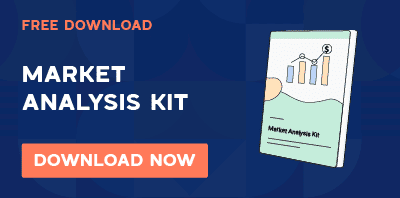I stare at my screen as the clock ticks past 2 AM. I’ve got 12 browser tabs open, each brimming with statistics, customer survey data, and industry reports.
The problem? Traditional market research is painstaking. As a small business owner, I didn’t have a research team or weeks to spend digging up data. I needed a shortcut, without sacrificing quality. That’s when I discovered the power of AI.
If I told you that the kind of research that used to take you hours or even days could now be done in just a few seconds, you’d be surprised, right? But it’s true.
With the help of AI, I can cut down my research time, effort, and money while getting sharper, data-backed insights in record time. But how to use AI for market research?
Let’s dive in and find out in this blog!
Can you actually rely on AI for market research tasks?
Yes, you absolutely can!
Tools like DeepResearch, Perplexity, and even ChatGPT-4 aren’t just making things up. These models are trained on large datasets, and some even go out and gather information from trusted sources across the web in real-time.
So, when you ask them something, they’re not guessing—they’re actually doing the research for you. It’s like having a research assistant who works fast, doesn’t sleep, and reads everything available.
For example, Perplexity blends AI with real-time internet browsing, pulling the latest facts and even providing the sources for you. If you want to try: Open Perplexity and search “price of Meta shares,” the platform will show you the real-time share price with the chart.
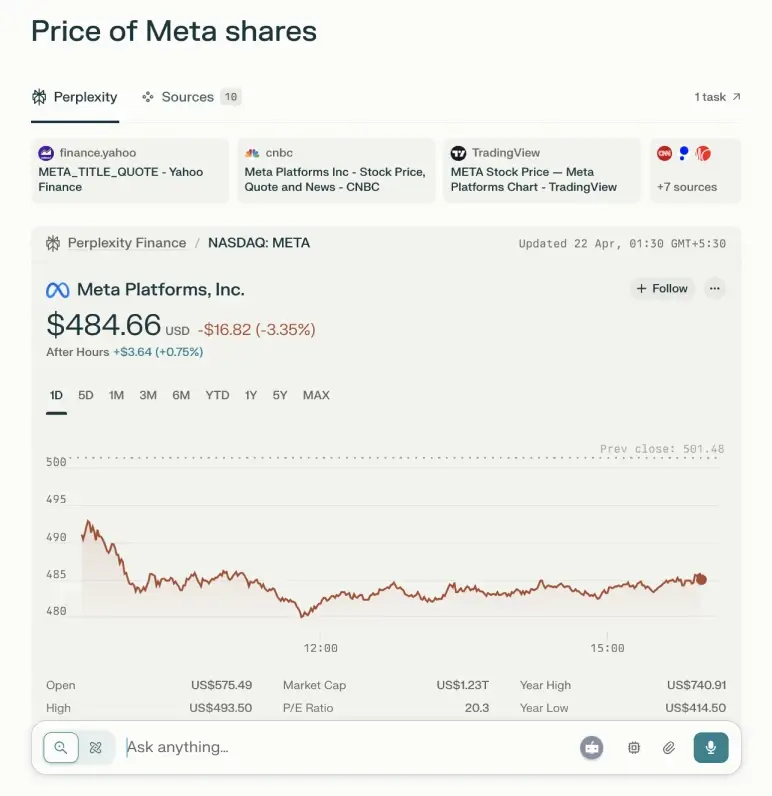
Above all, it will help you with research by providing information on share performance, market capitalization, analyses of shares, and estimates. This cuts down your research time and helps you make informed decisions faster.
Google’s upcoming Gemini AI is set to offer similar features, which will scan hundreds of websites within seconds to deliver summarized insights. As for the AI built into Upmetrics, it’s tailored to pull real market data and trends that align directly with your business plan.
Using generative AI tools for market research
According to the U.S. Chamber of Commerce, AI systems can indeed provide “valuable insights on market trends.” Thus, let’s get into its nitty-gritty and understand how AI generates results on different aspects of market research.
Here are some of the core steps I take when researching a market, and how I use AI to tackle each one:
1) Identify & segment your target market
Identifying & segmenting is one of the most important aspects of market research, as if you skip this step or get it wrong, everything else in your business plan can go off track.
Why? Because if you don’t know who you’re selling to, how will you know what they want, where to reach them, or how to price your product?
Now, here’s where AI becomes a real game-changer. Back in the day, I had to dig through reports, surveys, and government data manually. But now, tools like ChatGPT or Perplexity can do the heavy lifting.
You just need to ask the right questions—called “prompts”—and they’ll help you figure out who your audience is based on industry, demographics, location, behavior, and more.
You can use an example prompt: “I’m opening a vegan bakery in Seattle. What are 3-4 key target market segments I should focus on?”
With the input I entered into Gemini and Upmetrics, it responded with the following information.
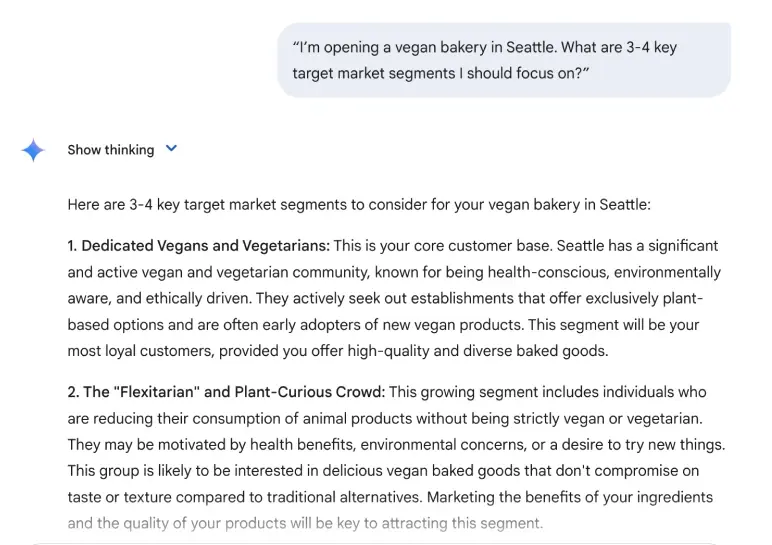
Upmetrics reply:

Findings: AI platforms have delivered useful research on identifying target audiences. Both platforms might deliver slightly different ideas and results, but the information they provide is valuable and has significantly reduced the amount of manual research needed.
2) Develop a buyer persona for each segment
Once you’ve figured out who your target market is, the next smart move is to create a buyer persona for each segment. A buyer persona is basically a detailed, imaginary profile of your ideal customer in each group.
It covers their age, job, income, lifestyle, what problems they face, what they value, and how they like to shop.
Why is a buyer persona important? Because the more you know about your customer, the better you can speak their language, solve their problems, and sell them exactly what they’re looking for.
Now, this is how AI can assist you in gathering data for your buyer personas. All you need to do is enter a prompt, and here’s the one I used for the AI platform.
Example prompt: “Create a buyer persona for a health-conscious millennial who might visit a vegan bakery. Include age, occupation, goals, and what they look for in a bakery.”
This is what the AI platforms come up with:
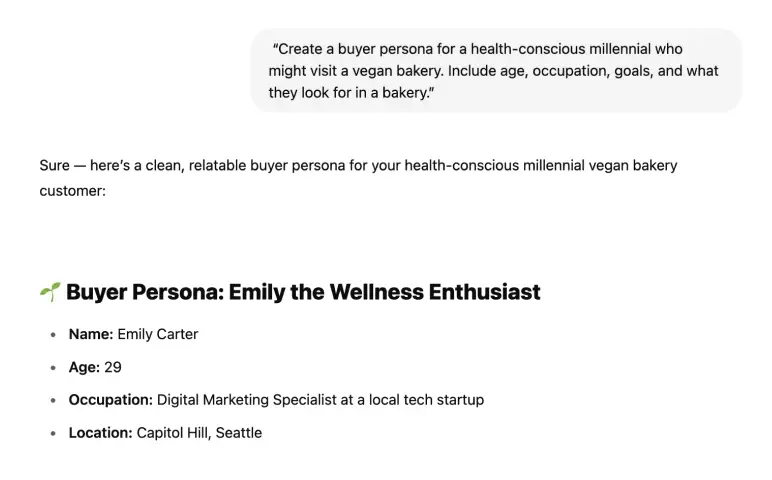
Upmetrics reply:
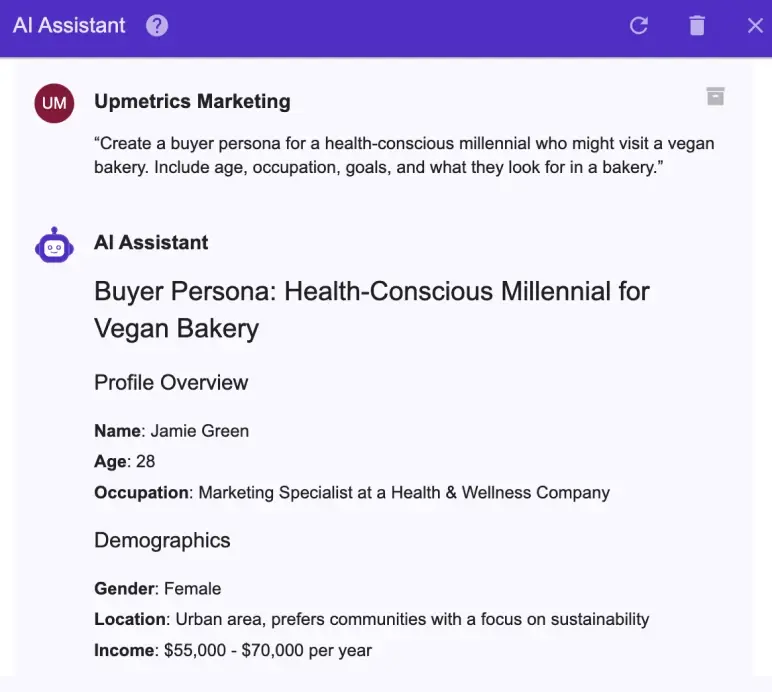
Key takeaway:
No doubt, AI platforms have made your work a whole lot easier. Earlier, you’d spend hours doing this kind of research manually, but now, AI delivers it to you in just a few seconds.
Not only that, but it also structures the information for you, saving you the extra time you’d spend organizing everything. This means you can make quicker, smarter decisions without getting stuck in endless research. So, use AI wisely and let it handle the heavy lifting while you focus on planning your next move.
3) Estimate market size and potential
It’s important to determine the size and potential of your market to know whether it’s worth investing your time, money, and energy into this idea. However, estimating market size and its potential manually may take days, months, or even years.
Additionally, estimating your market manually includes the expense of professionals, resources, and paid reports, which can quickly eat into your budget, especially if you’re just starting out.
But with AI platforms, you can get numbers and estimates in a few seconds without breaking the bank. Let’s try out estimating market size with ChatGPT, followed by Gemini.
Here’s the prompt I used to get market size and its potential: “What is the total market size for vegan baked goods in the U.S., and is it growing?”
And the results are:
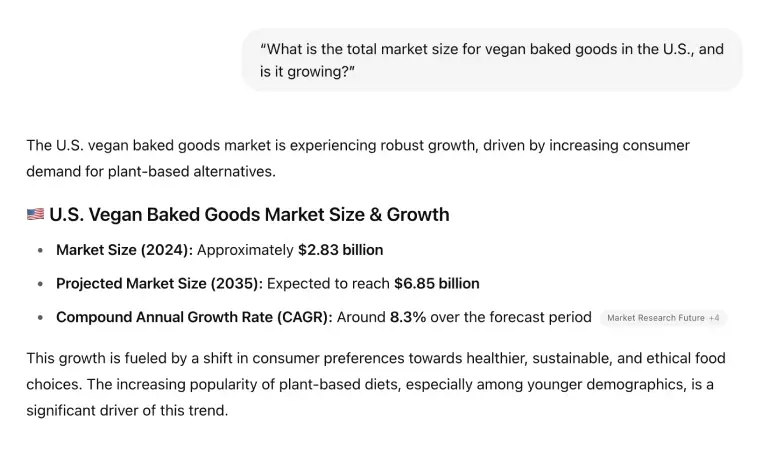
Now, let’s check on Upmetrics:
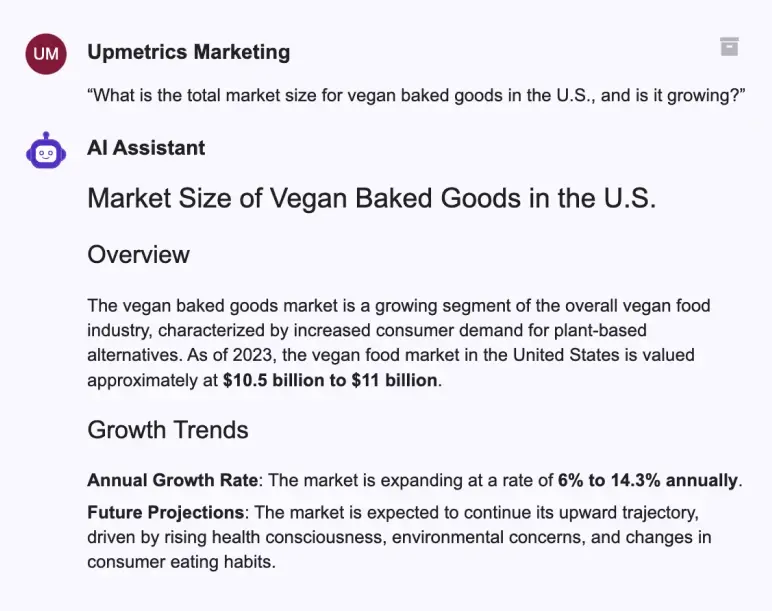
Findings: All platforms offered valuable insights on market value and potential. But keep in mind you’ll only get the latest, up-to-date stats if you’re using their premium versions. Otherwise, their data might be limited up to January 2025, and you might need to dig a little deeper for the most recent figures.
However, you can use the resources provided at the end of the information to find the latest stats. That said, the information they provide is more than enough to help you kickstart your business and make smart, informed decisions right away.
4) Analyze Market Trends
One of the biggest mistakes people make when starting a business is ignoring what’s happening around them. The market isn’t standing still; it’s always changing.
New products, customer habits, technology shifts, and social preferences pop up all the time. These trends tell you what people are starting to care about and where the business world is headed.
Here’s how you can be with trends using AI for market research and keep your business ahead of your competitors:
To stay updated on the latest trends, I tried both platforms, ChatGPT and Gemini, and here’s what they came up with for me.
The prompt I used is: “What are some emerging trends in the vegan food market in 2025?” In response, AI replied:
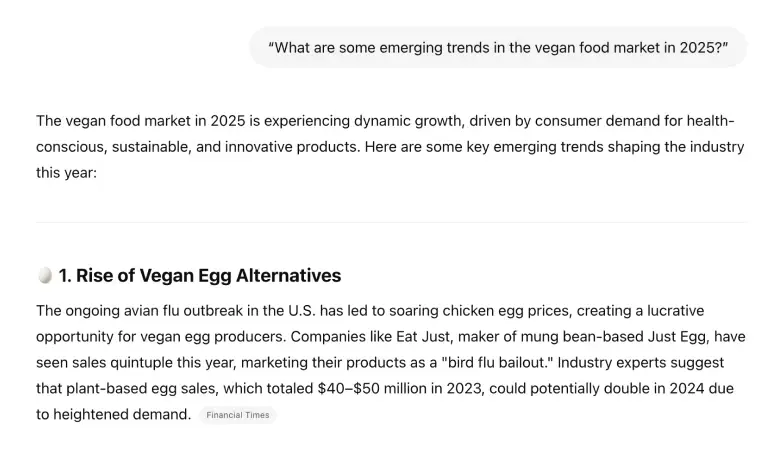
Gemini’s answer:
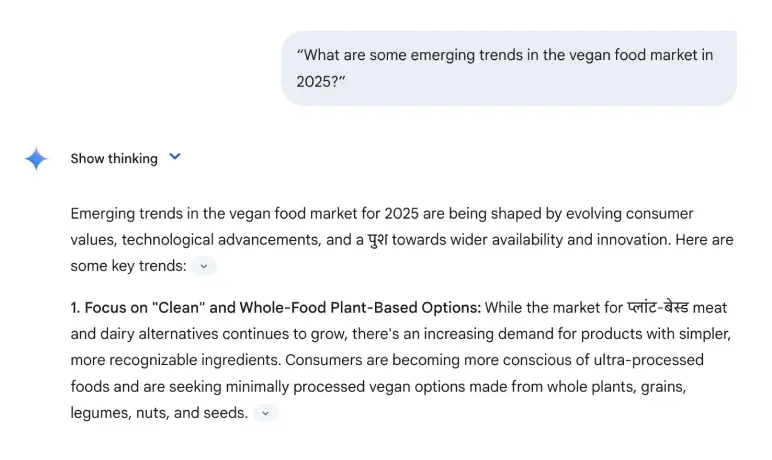
5) Analyze consumer behavior and sentiment
Numbers and trends are important, but at the end of the day, it’s people who buy your products. Hence, understanding how they think, feel, and behave is what makes a business truly successful.
So, what you might do to analyze consumer behavior is run surveys, focus groups and read through customer reviews line by line.
But today, AI platforms can scan through customer reviews, social media posts, blog comments, and forums to pick up on what people love, what annoys them, and what they wish brands would offer.
It even gauges emotions behind the words, like excitement, frustration, or disappointment. So, let’s try it out and see how impactful these AI platforms are to gauge the consumer behavior:
Here’s the prompt that I used in ChatGPT and Upmetrics AI research assist: “What do people say about vegan desserts online?”
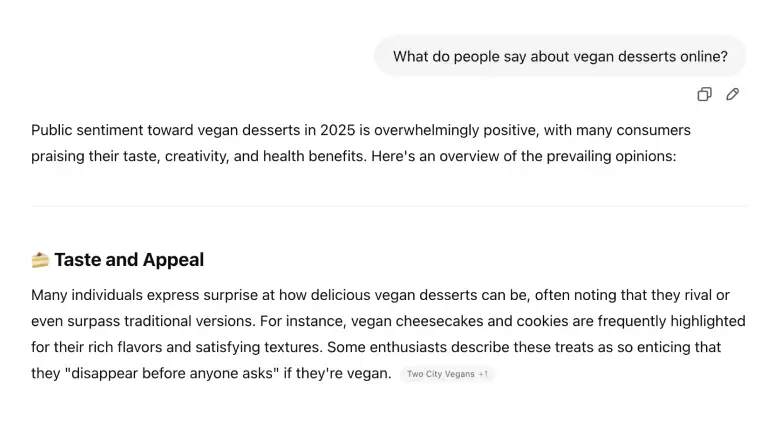
Upmetrics reply:
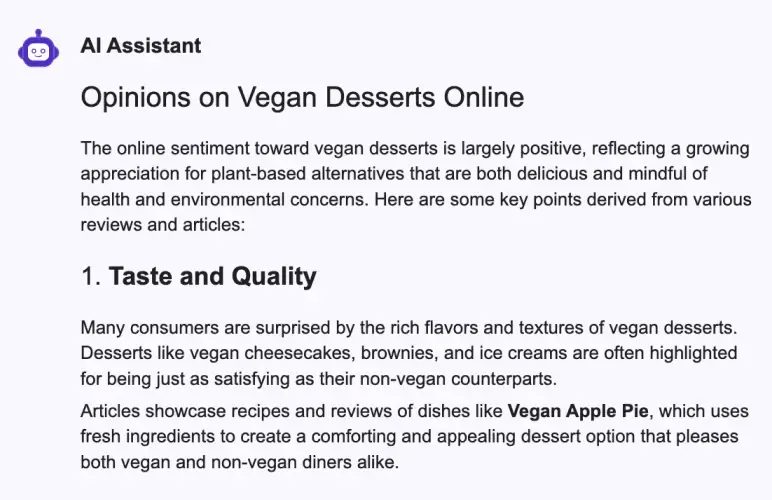
Findings: AI platforms have efficiently generated clear insights on customer behavior and sentiment. They’ve highlighted what people appreciate, what frustrates them, and what improvements they expect, without manually sifting through endless reviews and posts.
6) Process and organize raw data
Sometimes, you don’t just deal with ready-made reports or online stats. You’ll have raw data to handle—like survey results, spreadsheets filled with numbers, or even interview transcripts. And trust me, going through all that manually is a headache.
I remember this one time—I had a Google Sheet loaded with people’s responses about what they wanted in a bakery. Now, instead of sitting there, going through each response one by one like we used to back in the day, I simply copied all that text, dumped it into an AI tool, and gave it a prompt:
“Here are 100 survey responses about what people want in a bakery. Can you summarize the key takeaways?”
And just like that, within seconds, the AI handed me a clean, organized summary. It told me most people cared about taste, quite a few mentioned price, and a lot asked for more gluten-free options. No spreadsheet formulas, no hours lost.
The best part? Some AI tools these days can even work directly with spreadsheets and run basic stats for you. And just like that, within seconds, the AI handed me a clean, organized summary.
It told me most people cared about taste, quite a few mentioned price, and a lot asked for more gluten-free options. No spreadsheet formulas, no hours lost.
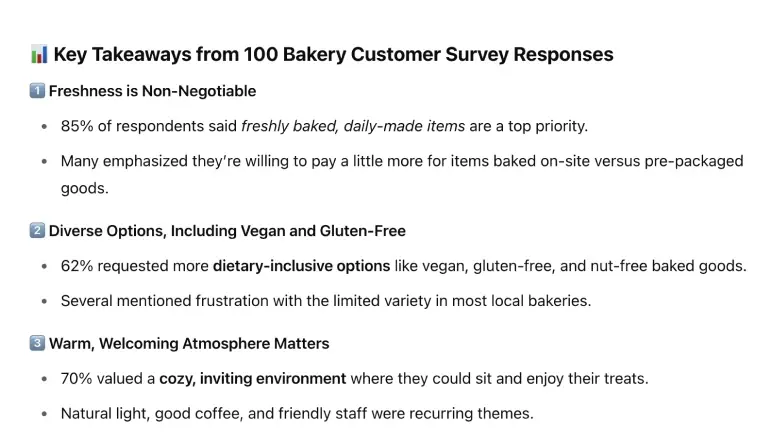
7) Assess customer pain points using public forums
One of the best ways to understand what people really struggle with is by checking out what they’re complaining about online. Places like Reddit, Quora, and those little Facebook groups are full of unfiltered, honest opinions.
People don’t hold back there. The only problem? Digging through all those endless posts and threads can eat up your entire day. That’s where AI makes life so much easier. What I do is, I’ll type in a prompt like:
“What common problems or complaints do people mention on Reddit about home baking?”
If you’ve got a generative AI with browsing turned on, it’ll go through those forums, pick out the repeating problems people keep talking about, and bring them to you in a neat little list.
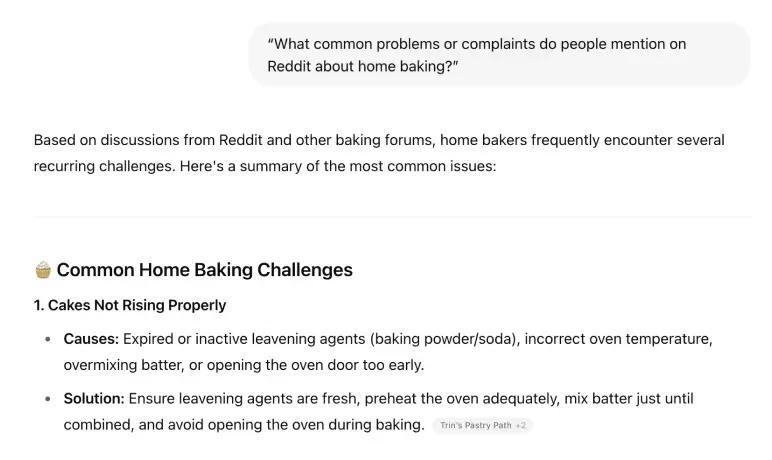
By doing this, AI hands you real, raw pain points directly from your potential customers. Because when you know what’s bugging your audience, you can build products, services, or even FAQs that solve those exact problems. It’s smart, it’s quick, and it’s how you stay one step ahead in business.
Best generative AI tool for market research
By now, you’ve probably got a good sense of what these AI platforms can do. Hence, to make the most out of AI and market research, I’m going to share my go-to generative AI tools, the ones I personally rely on and highly recommend.
Let’s explore:
ChatGPT (OpenAI):
| Best for | Quick idea validation, market trends analysis, summarizing data, and writing insights |
| Key features | Naturally converse like humans and provide useful information |
| Pros | Easy to use, fast responses, and handles unstructured data well |
| Cons | Limited real-time data, unless browsing is enabled, can generate outdated or generic answers |
| Price | Free – Basic plan $20/month – ChatGPT-4 |
| Integration | Can integrate via API with apps like Slack, Notion, and Google Sheets via third-party tools |
If there’s one tool I’d tell you to get comfortable with for AI-powered market research, it’s ChatGPT. I’ve been using it for a while now, and trust me, it’s like having a super-fast, super-smart assistant sitting right next to you.
Upmetrics AI Research Assistant:
| Best for | Business plan-specific market research, competitor analysis, financial forecasting, and tailored insights |
| Key features | Context-aware research, integrated inside a business plan tool, AI-powered financial projections, and market trend summaries |
| Pros | No need to switch apps, personalized to your business, saves time in business planning, and is beginner-friendly |
| Cons | No need to switch apps |
| Price | Paid plans starting from $9/month |
| Integration | Fully integrated inside the Upmetrics platform — no third-party integration required |
Upmetrics AI Research Assistant is built directly into the Upmetrics business plan software. It’s typically different from ChatGPT or Perplexity. Once you feed it the basic details about your business, like what you’re selling, who your audience is, and which section of the plan you’re working on, it starts tailoring its research just for you.
When you move from the idea stage into serious business plan writing, this tool makes life a whole lot easier.
Perplexity:
| Best for | Real-time information, quick fact-checking, instant answers, and decision support |
| Key features | AI-powered search engine, conversational answers, citation-based responses, and real-time web results |
| Pros | Fast, reliable, easy to use, pulls info from live web, and good for validating stats quickly |
| Cons | The free version has limited browsing, not built for deep market analysis |
| Price | Free – Basic plan $20/month – Pro version |
| Integration | No direct integration with business planning apps |
Perplexity is one of the gems when you need real-time, up-to-date information. Unlike some tools that rely on older data, Perplexity actually browses the internet live when you ask it something.
I often use it when I need to collect quick insights before a client call or while drafting a business plan section. It makes those last-minute decisions a lot easier because you’re working with the latest facts, not outdated guesses.
Google’s Gemini:
| Best for | Generating insights, market summaries, and brainstorming ideas with Google ecosystem compatibility |
| Key features | Integrates with Google tools (Docs, Sheets), image & code understanding, multi-modal capabilities |
| Pros | Smooth Google Workspace integration, good for summarizing data, evolving real-time web access, and a clean interface |
| Cons | Still developing real-time browsing, occasional inconsistent results, not tailored for the business plan context |
| Price | Free – Basic plan $19.99/month – Advanced version |
| Integration | Strong integration with Google Workspace apps (Docs, Sheets, Gmail, etc.) |
Google’s Gemini is another AI tool you should keep an eye on. Now, it’s still in development when it comes to providing full real-time information like Perplexity, but it’s quickly catching up. And even in its current state, it’s quite handy for market research tasks.
Using Upmetrics AI for market research
That’s a wrap! In this blog, we explored how AI can simplify market research by testing different tools and seeing what they’re capable of. And honestly, these tools didn’t disappoint.
They responded well to our prompts, delivered valuable insights, and made the entire research process a whole lot smoother. While each tool has its own strengths, the one that truly stands out is Upmetrics’ AI Research Assistant.
What makes it special is how it works alongside you like a personal business assistant. Whether you need market insights, data analysis, financial reports, or help drafting your business plan, it’s right there with you. No juggling between apps or wasting days on research.
With Upmetrics AI in market research, what could normally take weeks or months can be wrapped up in 20-30 minutes.
Ready to give it a try? Get in touch with experts.


